Reflex Locomotion – The Fundamentals of Vojta Therapy
Vojta Therapy
According to Vojta, reflex locomotion is activated from the three main positions: prone, supine and side lying. To stimulate the patterns of movement, there are—as described by Vojta—ten available zones on the body and on the arms and legs. Through a combination of different zones and changes in pressure and extension both patterns of movement, reflex rolling and reflex creeping, can be activated. Furthermore, an important role is played by optimal joint angles in the extremities and so-called resistances, whereby the therapist sets up a resistance against the sequence of segmental movements in the current pattern of movement. Thus, for example, the tendency to rotate the head during reflex creeping is resisted and held. In this way, tension in the musculature in the environment of the “resisted” body part increases, without further contraction (isometric contraction). Through this technique, moreover, muscular activities in other distal body parts (abdomen, back, arms, legs) are strengthened.
Two Coordination Complexes in Reflex Locomotion
In the practical use of reflex locomotion, there are two so-called coordination complexes:
- Reflex Creeping
- Reflex Rolling
Both complexes were first discovered, applied and had their reactions observed in children and young people with already established movement disturbances (e.g. spastic paralysis). Through observing the stimulation of healthy new-born babies it was only later realised that these were independent innate movement complexes that could also be employed in therapy with new-born babies.
One Principle – Many Variations
The movement sequences of reflex locomotion are retrievable at all times. The three main positions—prone, supine and side lying—have more than thirty variations. By combining and varying stimulation zones and resistances, as well as making slight changes in directions of pressure and joint angles in the starting position, therapy can be adapted to the patient’s individual clinical picture and treatment goal.
1. Reflex Creeping
Reflex creeping is a movement sequence that includes the most fundamental components of locomotion:
1. Specific postural control
2. Uprighting or extension against gravity and
3. Goal-directed stepping movements of the arms and legs.
Thus, reflex creeping encompasses the basic patterns of the human locomotion. The main position is prone lying with the head resting on the bed rotated to one side.

The above illustration shows the starting position for reflex creeping and its stimulation zones. These “stimulus points”, in conjunction with the joint angles of the extremities and of the head, start the motor sequence for the creeping sequence with its muscular activities
In new-born babies, reflex creeping can be fully activated from one zone; in older children and in adults, a combination of several pressure points is necessary.
Movement predominantly ensues in the so-called cross pattern, in which the right leg and the left arm, or vice versa, move simultaneously. A leg and its contralateral arm support the body and move the trunk forwards.
The resulting sequence is shown below.
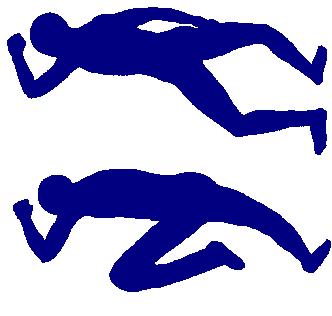
The Reflex Creeping Sequence
In therapy, the therapist sets up an adequate resistance against the patient’s incipient head rotation. This strengthens the activation of the overall body musculature, thus creating the pre-conditions for uprighting.
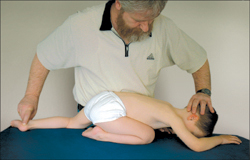
Reflex Creeping – Activation in Prone Lying
The goals of reflex creeping are notably:
-
Activation of the muscular support and uprighting mechanisms necessary for supporting and grasping, rising and walking, as well as stepping movements of the arms and legs
-
Activation of the respiratory, abdominal, and pelvic floor musculature, as well as the sphincters of the bladder and bowel
-
Swallowing (important for mastication)
-
Eye movements
Reflex rolling transitions from supine to side lying and leads to crawling. In a healthy new-born baby, part of this movement sequence is spontaneous, and can be observed in approximately the sixth month of life, with a further part of the sequence observable in the eighth/ninth month. With Vojta therapy, it can even be obtained in new-born babies. Therapeutically, reflex rolling is used in different phases of supine and side lying:
1. Phase
The first phase starts with supine lying, arms and legs extended. Through stimulation of the breast zone in the intercostal space (7th/8th ribs) beneath the nipple on the mammillary line, rotation to the side is achieved. Rotation of the head is resisted by the therapist/practitioner.

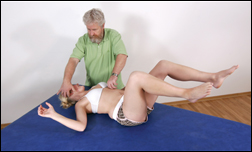
1. Phase of Reflex Rolling: Activation in Supine Lying with New-Born Babies and Adults
The fundamental reactions are:
-
Extension of the spine
-
Flexion of the legs in hip, knee, and ankle joints
-
Maintenance of the legs in this position against gravity, outside the support base of the back
-
Preparation of the arms for the following support function
-
Lateral eye movements
-
Initiation of swallowing
-
Increase in the depth of breathing
-
Coordinated, differentiated activation of the abdominal muscles
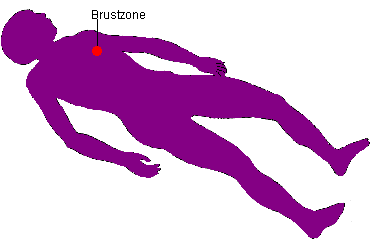

Reflex Rolling: Activation from Supine Lying
2. Phase
The second phase of reflex rolling has its onset in side lying. It encompasses movement sequences that are also present in spontaneous rolling, crawling and lateral movement. The underlying upper arm and the underlying leg support the body. They move it upwards and forwards against gravity. In so doing, muscular activation in the underlying arm proceeds from the shoulder to the elbow and finally to the hand, where it finds support. The movement ends when the rolling sequence is completed in crawling.

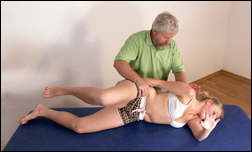
2. Phase of Reflex Rolling: Activation in Side Lying with New-Born Babies and Adults
Fundamental Reactions:
- Contrary flexion and extension movements of the over- and underlying arms and legs with increase in support function on the underlying shoulder progressing to the hand, and on the underlying pelvis progressing to the leg
- Extension of the spine during the entire rolling sequence
- Maintenance of the head in side lying, against gravity

Reflex Rolling: Activation in Side Lying
Even after treatment, the programme of the pattern of movement still remains active in the patient's brain for differing lengths of time. Thus, the patient’s spontaneous access to the patterns activated in multiple daily treatment intervals often persists for the whole day, and the patient exhibits a lasting improvement in posture, movement and perception.
The Comprehensive Effect
The movement sequences depicted in reflex locomotion according Vojta contain the basic patterns of movement used in individual development of normal motor functions for human posture and movement. Every patient must be treated individually in accordance with his primary illness and the possibilities and limits arising from it. Patients with various illnesses, such as cerebral palsy, spinal scoliosis or hip dysplasia and dislocation for example, can benefit from the broad spectrum of effects produced by the Vojta Method as shown. Even in severe cerebral movement disorders, there is a markedly positive influence on and favourable change in uprighting movements and the ability to communicate. The effect of Vojta Therapy on the patient can cover the following areas in particular:
Skeletal Musculature:
-
The spine is segmentally extended, rotated and is functionally more mobile.
-
The head can be moved more freely.
-
The joints centre themselves, especially at the hip and shoulder. Incorrect postures decrease.
-
The hands and feet can be used in a more goal-directed and comprehensive fashion for grasp and support functions.
Face and Mouth Area:
-
Sucking, swallowing and chewing movements are facilitated.
-
The eyes move themselves independently of the head and more goal-directed.
-
The voice becomes louder and stronger.
-
Speech acquisition is facilitated and enunciation becomes easier to understand.
Respiratory Function:
-
The rib cage widens.
-
The breathing becomes deeper and more even.
The Autonomic (Involuntary) Nervous System:
-
There is better blood circulation to the skin.
-
The sleep-wake rhythm improves.
-
The regulating functions of the bowel and the urinary bladder are activated.
Perception:
-
Equilibrium reactions are improved.
-
Orientation in space becomes better.
-
The sensations – cold, warm, sharp or dull – become stronger or more accurate.
-
Own proprioception becomes more distinct.
-
The recognition of forms and structures exclusively through touch (stereognosis) becomes better.
-
The ability to concentrate becomes more persistent and more flexible.
The Mind:
-
The patient seems more balanced, happier and is more emotionally resilient.
Implementation: Team Work

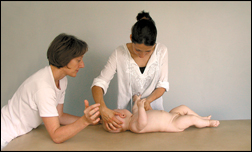
Precise instruction from the Vojta therapist reassures the mother about treating her child at home
For Vojta Therapy to be successful, it must as a rule be performed several times a day (up to four times where necessary). A therapy session lasts between five and twenty minutes. Since parents or caregivers perform the therapy daily, they play a significant role in the application of Vojta Therapy.
As well as the primary illness, exercise intensity, frequency and accuracy determine the efficacy and ultimately the success of treatment. After referral to Vojta Therapy by the doctor, the Vojta therapist draws up an individual programme and determines the goals of therapy jointly with the patient/parents. The treatment technique should be taught promptly to parents or caregivers so that therapy can also be started at home and the necessary treatment intensity can be reached. During therapy, which can last weeks or months—in some cases even years—, the Vojta therapist should always be supportive to the parents. The therapy programme, the frequency and, where necessary, breaks in therapy are determined at regular intervals in accordance with the patient’s development.








